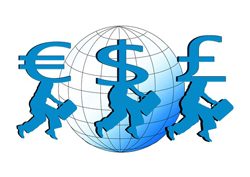 Do you plan to sell products online to an overseas market? If so, then it’s a great idea to think about providing your web visitors with a currency conversion service.
Do you plan to sell products online to an overseas market? If so, then it’s a great idea to think about providing your web visitors with a currency conversion service.
Currency converting tools allow your web visitors to have the price of an international currency transaction converted into their home currency when purchasing products on e-commerce sites. It also allows customers to view the exact amount their credit card or PayPal account will be charged, displayed in their own home currency.
The obvious advantage of adding currency conversion to your website is that it lets visitors see and understand prices in foreign countries in their own local currency, making it it easier for visitors to work out their costs and expenses.
Fortunately, if you are a WordPress user, you can add a currency conversion plugin to currency conversion to WordPress using a plugin, allowing your site visitors to easily calculate the cost of your products.
Currencyr – WP Currency Conversion Plugin
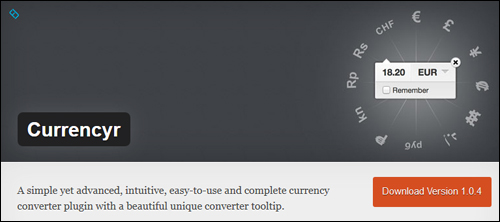
Currencyr is a simple, easy-to-use and complete currency converter plugin with a unique and attractive converter tooltip. It’s also free!
Plugin features include the following:
- Inline converter
- Supports various exchange rates providers, like Google, Open Exchange Rates and FoxRates
- Support database cache driven for fast response
- Widgetized currency table and converter
- Supports integration with a number of e-store plugins such as WP-eCommerce and Easy Digital Downloads.
- Can determine local currency automatically
- Full translation support
Note: The Currencyr plugin requires your server to be running PHP 5.3.0 or later. Do not use this plugin if you are running an older version of PHP on your server. Ask your web host to update your PHP server installation if necessary.
***
You can install the Currencyr plugin from your WP admin area by searching for “currencyr” in the Plugins section and clicking “Install Now” …
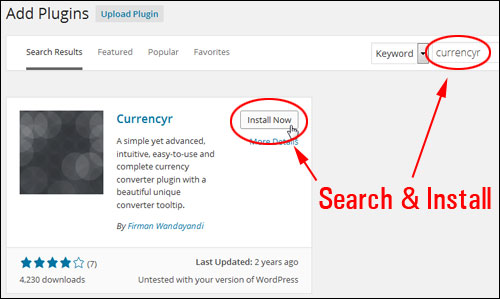
After the plugin has been installed and activated, you can access the plugin’s settings by selecting Currencyr from your admin area …
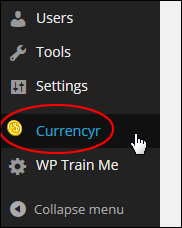
This takes you to the plugin settings area …
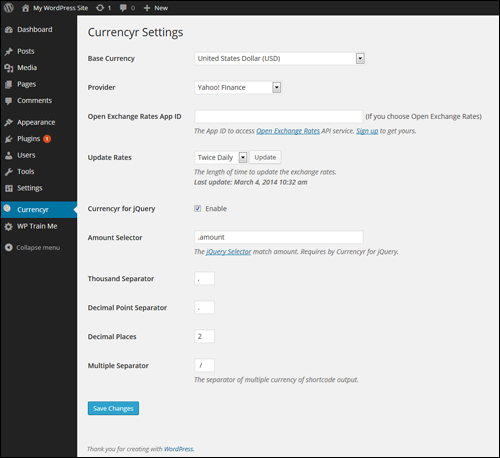
For example, you can choose a base currency from the Base Currency drop-down menu if you prefer to use a different currency than the default option (USD) …
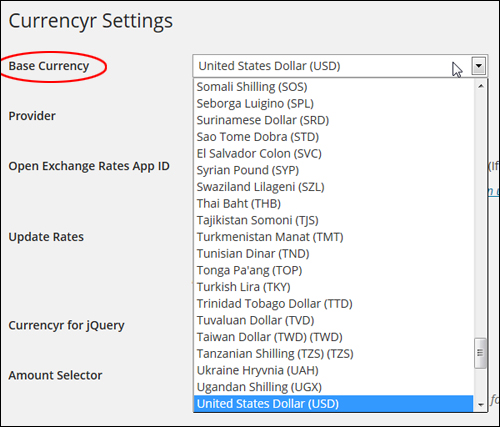
You can also choose which data provider you want to use from a drop-down menu. The default provider is Yahoo Finance, but you can choose one of the other options, like European Central Bank, FoxRate, Google Finance or Open Exchange Rates …

Note: If you select ‘Open Exchange Rates’, an API (Application Programming Interface) will be required …

You can choose how often you want to update the exchange rates by selecting an option from the Update Rates drop-down menu …

The plugin uses jQuery, which is an open-source library of Javascript code that lets web developers add things like animation effects to web applications (e.g. WordPress plugins).
If you have no reason to modify the jQuery settings, leave these as they are …

Edit the remainder of the plugin settings and remember to click ‘Save Changes’ when you have finished configuring all of your settings …
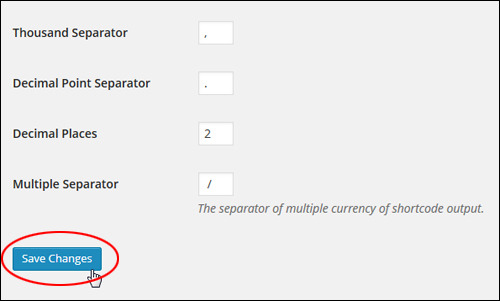
When you have configured your settings, you can easily add currency conversion to any WordPress page using shortcodes.
Refer to the ‘Additional Plugin Notes’ section further below to learn more about using currency codes (e.g. USD, GBP, CAD, etc …) in the Currencyr plugin.
Currencyr Shortcodes
You can easily add currency conversion to pages, posts and widgets with no web coding skills or knowledge using shortcodes.
Let’s take a look at some examples of currency shortcodes that you can add to pages and posts:
Let’s say that you sell an item for a set amount (e.g. $175) in US Dollars (USD), and you would also like to display this conversion amount in British pounds (GBP) on your product sales page.
To do this, simply add the following shortcode into your post or page …

Note: You can also display amounts in dollars and cents (e.g. 175.00, 22.00, 399.99, etc …)
The screenshot below shows how your shortcode will look after you have added it to a page or post …
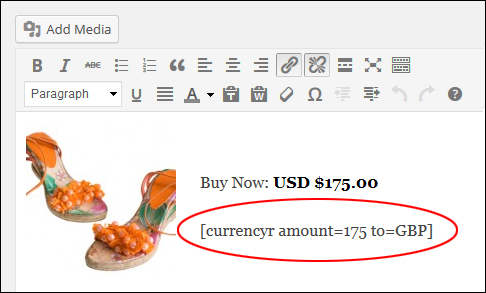
After the post or page has been published, the converted currency amount will appear as seen in the example below …

Using the above example, let’s now convert the same price into different currencies.
To do this, use the shortcode shown below (add as many currency symbols as you want by using vertical pipes) …

The example below now shows how the above shortcode appears when inserted into a page …

After publishing the information, your currency conversion will then display as seen in the screenshot below …

refer to the ‘Additional Plugin Notes’ section further below to learn more about changing the currency separator symbol with the Currencyr plugin.
Now, let’s suppose that you would like to select a different base currency than the one set as your default.
For example, if you have set your default base currency as EUR and you have a section on your site targeted to customers from countries like Australia or Canada, you can change the base currency using the following shortcode …

The screenshot below shows how the above shortcode looks when you add it to a page …
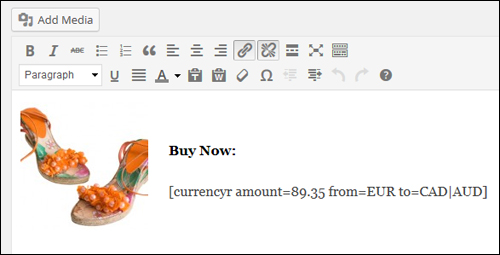
After publishing your page or post, the converted currency will then appear as seen in the screenshot below …
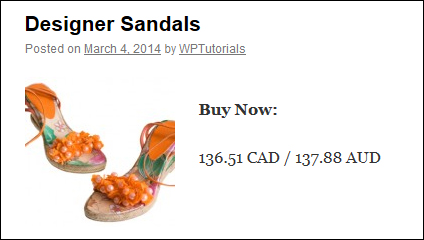
Widget
You can also add a currency converter to your website’s sidebar using a widget.
To add currency conversion to your sidebar menu, select Appearance > Widgets in your WP admin menu …

In the Widgets > Available Widgets area find the ‘Currencyr’ widget and drag it to an Active Widgets area …

Configure the widget settings as shown below (add currency codes separated by a comma), and click Save to save your settings …
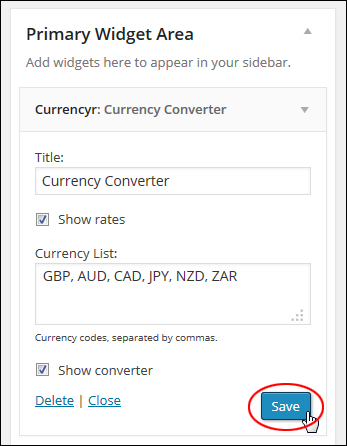
Your currency conversion tool will now show on your website’s sidebar menu with the options you have specified …
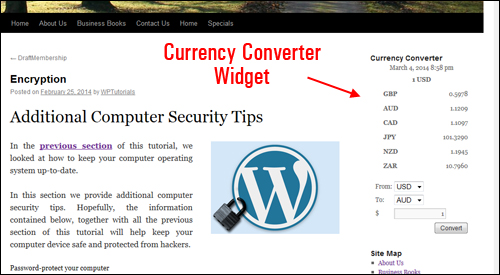
Additional Plugin Notes
Here are some additional notes and useful information about using the plugin.
Currency Separator
The Currencyr plugin lets you specify a symbol of your choice to display as the currency separator when using several currencies.
You can select a different symbol in the ‘Multiple Separator’ settings section.
So, for example, using the default symbol “/” (forward slash) …

Displays your currency values separated by a forward slash as you can see in the screenshot below …
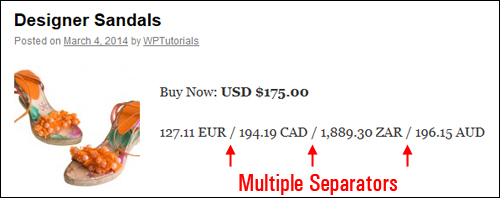
If you specify another symbol and update your settings …

Your web site visitors will see the new symbol being used as the currency separator …
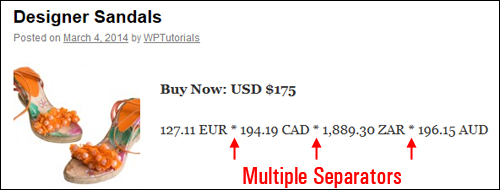
Using The Plugin With WordPress-Compatible e-Commerce Software
As described earlier, the Currencyr plugin integrates with a number of WordPress-compatible e-commerce plugins such as WooCommerce, WP-eCommerce and Easy Digital Downloads …

(image source: plugin website)
Congratulations! Now you know how to easily add a currency converter to your WordPress site.
To learn more about WordPress e-commerce plugins, see the tutorial below:
***
"I am beyond impressed with what you have put together. I can tell that you put a ton of hard work into building what you have. You have the absolute best content on WordPress I have ever seen!" - Robert T. Jillie